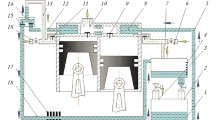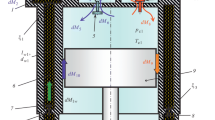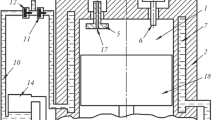Different methods of profiling the working cavity of the second stage of a volumetric hybrid piston power machine are considered. Profiling of the working chamber in order to achieve a constant velocity of the liquid piston and attain the maximal magnitude of the heat-exchange surface, as well as profiling of the surface of a working chamber consisting of a cone and cylinder are performed. Computational formulas in analytic form are obtained in order to create a profiled surface that satisfies the first two conditions. For the third condition criteria for estimating the efficiency relative to the maximal magnitude of the heat-exchange surface and relative to the deviation of the velocity of the liquid piston from some constant velocity of the liquid in the working chamber are developed. As a result of a numerical experiment forms of the working chamber that satisfy the first two conditions are established and it is proved that a conical surface is best for a working chamber consisting of a cone and cylinder.






Similar content being viewed by others
References
D. G. Svoboda, A. A. Zharkovskii, and E. A. Ivanov, “Influence of the geometric parameters of the impeller of a free-vortex pump on the energy and cavitation characteristics of the pump,” Chemical and Petroleum Engineering, 54. I, No. 9–10, 673– 680 (2019).
P. I. Plastinin, Piston Compressors, Vol. 1 [in Russian], KolosS, Moscow (2006).
V. Ye. Shcherba, A. P. Bolshtyanskii, S. Yu. Kaygorodov, and D. A. Kuzeeva, “Analysis of basic advantages gained by combining a volumetric compressor and a volumetric pumpinto a unified whole,” Vest. Mashinostroeniya, No. 12, 15–19 (2015).
V. Ye. Shcherba, A. P. Bolshtyanskii, V. V. Shalay, and Ye. V. Khodyreva, Pump-Compressors. Working Processes and Design Fundamentals [in Russian], Mashinostroenie, Moscow (2013).
A. V. Zanin, V. Ye. Shcherba, Ye. Yu. Nosov, et al., “Development and investigation of an experimental model of a two-stage volumetric hybrid piston power machine,” Dinamika Sistem, Mekhanizmov i Mashin (Dynamics of Systems, Mechanisms, and Machines), 7, No. 1, 54–61 (2019).
V. Ye. Shcherba, A. V. Zanin, Ye. Yu. Nosov, et al., “Calculation of parameters of processes of compression and injection of twostage hybrid piston power machine with liquid piston,” Khimicheskoe i Neftyegazovoe Mashinostroenie, No. 8, 15−20 (2019).
V. N. Martynov, Development and Investigation of Pump-Compressor Plants for Compression of Gases and Gas-Liquid Mixtures [in Russian], Candidate’s Summary of Dissertation for the Degree of Candidate in Technical Sciences, Moscow (2009).
Author information
Authors and Affiliations
Corresponding author
Additional information
Translated from Khimicheskoe i Neftegazovoe Mashinostroenie, Vol. 56, No. 2, pp. 26−31, February, 2020.
Rights and permissions
About this article
Cite this article
Shcherba, V.E., Shalai, V.V., Pustovoi, N.V. et al. On Profiling of the Working Cavity of the Second Stage in a Hybrid Piston Volumetric Power Machine. Chem Petrol Eng 56, 125–136 (2020). https://doi.org/10.1007/s10556-020-00749-0
Published:
Issue Date:
DOI: https://doi.org/10.1007/s10556-020-00749-0




